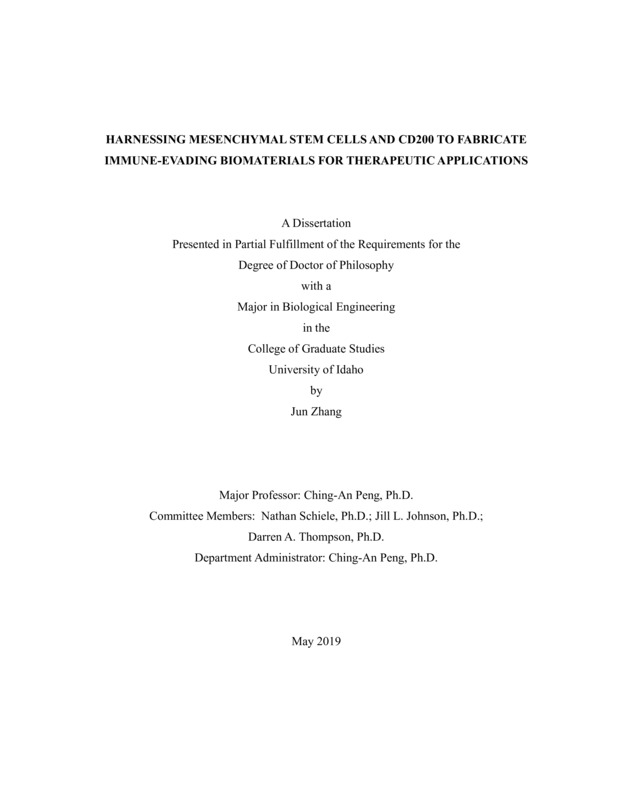HARNESSING MESENCHYMAL STEM CELLS AND CD200 TO FABRICATE IMMUNE-EVADING BIOMATERIALS FOR THERAPEUTIC APPLICATIONS
Zhang, Jun. (2019-05). HARNESSING MESENCHYMAL STEM CELLS AND CD200 TO FABRICATE IMMUNE-EVADING BIOMATERIALS FOR THERAPEUTIC APPLICATIONS. Theses and Dissertations Collection, University of Idaho Library Digital Collections. https://www.lib.uidaho.edu/digital/etd/items/zhang_idaho_0089e_11524.html
- Title:
- HARNESSING MESENCHYMAL STEM CELLS AND CD200 TO FABRICATE IMMUNE-EVADING BIOMATERIALS FOR THERAPEUTIC APPLICATIONS
- Author:
- Zhang, Jun
- ORCID:
- 0000-0003-0788-1915
- Date:
- 2019-05
- Embargo Remove Date:
- 2021-09-03
- Program:
- Biological & Agricultural Engineering
- Subject Category:
- Bioengineering
- Abstract:
-
Mesenchymal stem cells (MSCs) are multipotent stromal cells derived from bone-marrow. Antioxidants such as ascorbic acid and have been supplemented into the medium of MSCs to enhance the proliferation and differentiation of MSCs. In this study, astaxanthin, is a highly potent and lipid soluble antioxidant extracted from green algae Haematococcus pluvialis, was encapsulated by methoxy polyethylene glycol-polycaprolactone (mPEG-PCL) polymeric micelles to increase its aqueous solubility. Astaxanthin encapsulated mPEG-PCL was supplemented in the culture medium and chondrogenic, adipogenic and osteogenic differentiation medium to enhance the proliferation and differentiation of human MSCs. A thermo-sensitive polymer poly(N-isopropylacrylamide) (PNIPAAm) surface was then used to culture and harvest MSCs with a simple temperature switch. As a result, astaxanthin not only enhanced the proliferation of MSCs, but also promoted the differentiation of MSCs. MSCs can be harvested from PNIPAAm surface without using trypsin. Due to the intrinsic tumor-tropic feature of MSCs, MSCs are used in cancer therapy for drug and gene delivery. Carbon nanotubes (CNTs) are used in photothermal therapy because they can absorb near infrared (NIR) radiation and release heat. In this study, CNTs were anchored on the surfaces of human MSCs as a cell-based tumor-targeted system for potential application in photothermal therapy. As a result, CNT-tagged MSCs were able to migrate toward the chemoattractant SDF-1α when the amount of CNT on MSCs was no more than the threshold value 4.26 ng CNT per cell. MSCs also possess immunosuppressive properties. CD200 is an anti-inflammatory transmembrane glycoprotein expressed on MSC surfaces. The interaction between CD200 and its receptor CD200R has known to reduce macrophage activation and chronic inflammation. In this study, CD200 was appended on the surface of nano- and micro-sized polystyrene particles with CD200 to reduce macrophage phagocytosis. A polyethylene glycol (PEG)/CD200 co-immobilized biomaterial surface was also fabricated for reduced macrophage attachment. The results demonstrated that CD200 modification decreased macrophage phagocytosis activities for both nano- and micro-sized particles. PEG/CD200 co-immobilized surface showed delayed macrophage attachment as well as reduced interleukin-6 and TNF-α secretion from macrophages.
- Description:
- doctoral, Ph.D., Biological & Agricultural Engineering -- University of Idaho - College of Graduate Studies, 2019-05
- Major Professor:
- Peng, Ching-An
- Committee:
- Schiele, Nathan; Johnson, Jill L; Thompson, Darren A
- Defense Date:
- 2019-05
- Identifier:
- Zhang_idaho_0089E_11524
- Type:
- Text
- Format Original:
- Format:
- application/pdf
- Rights:
- In Copyright - Educational Use Permitted. For more information, please contact University of Idaho Library Special Collections and Archives Department at libspec@uidaho.edu.
- Standardized Rights:
- http://rightsstatements.org/vocab/InC-EDU/1.0/

